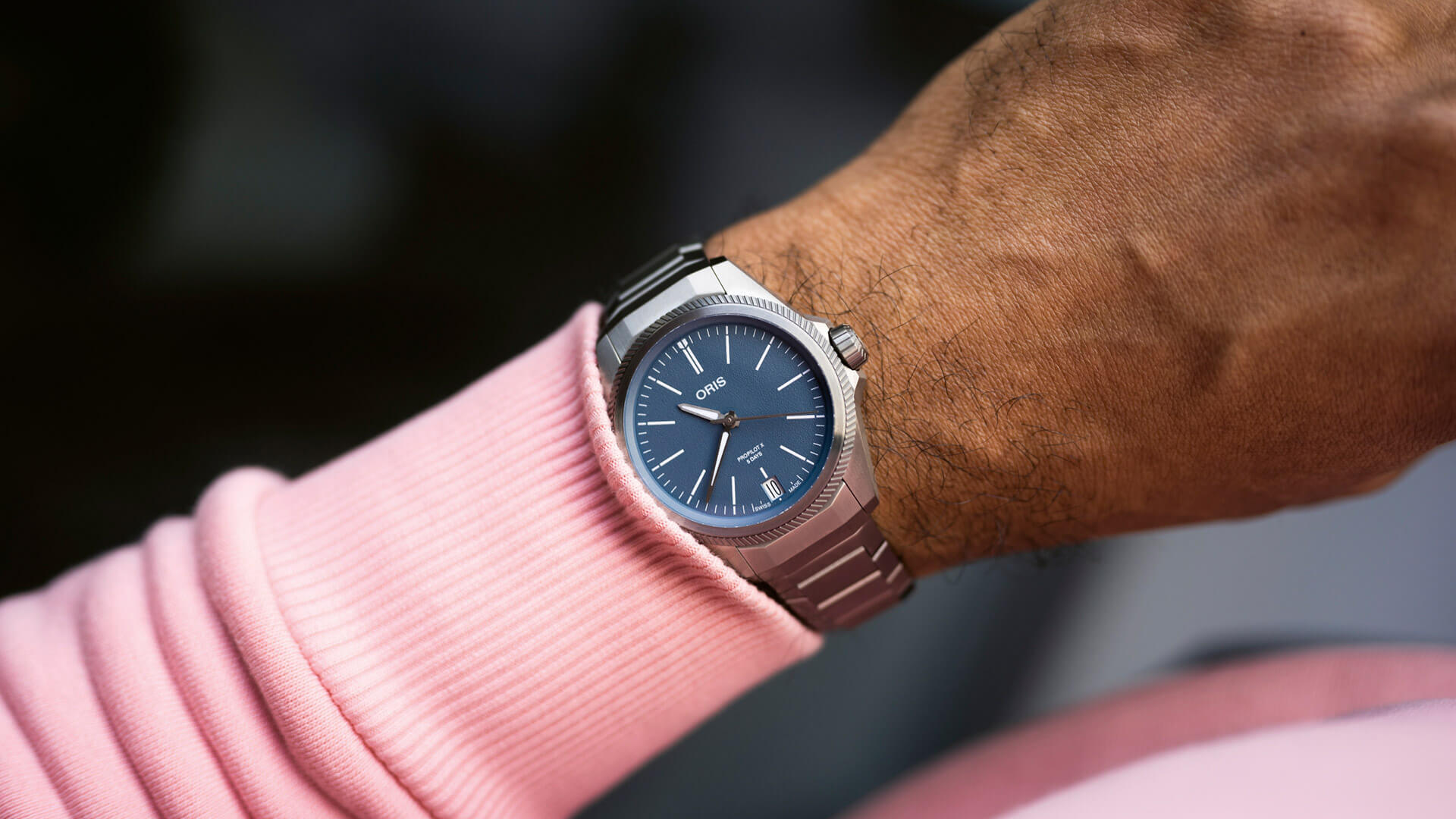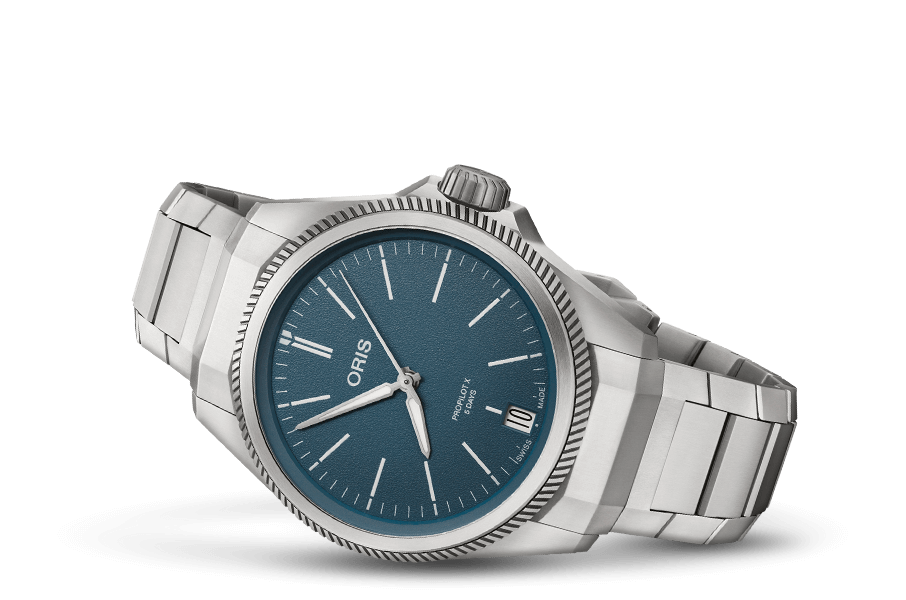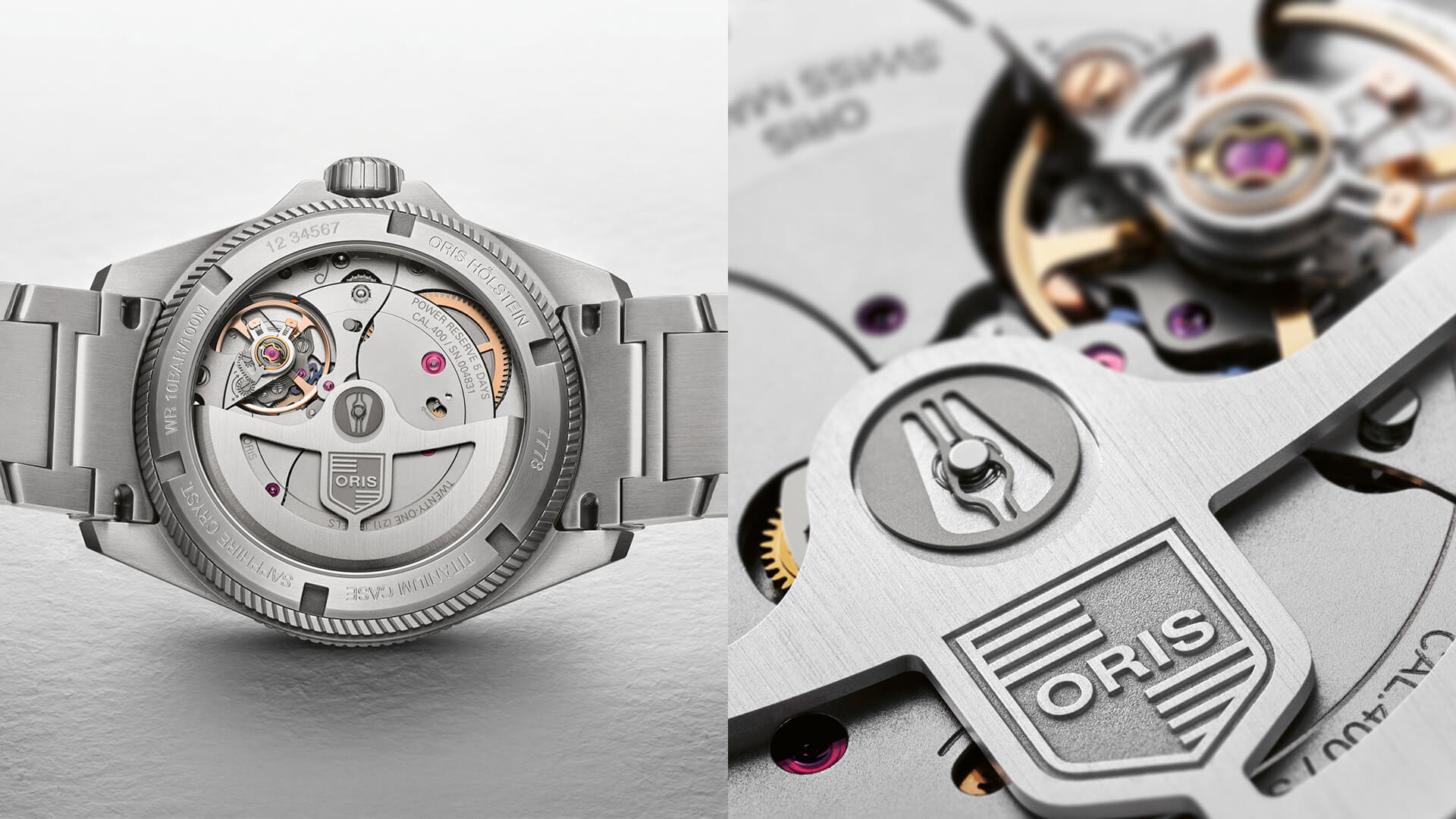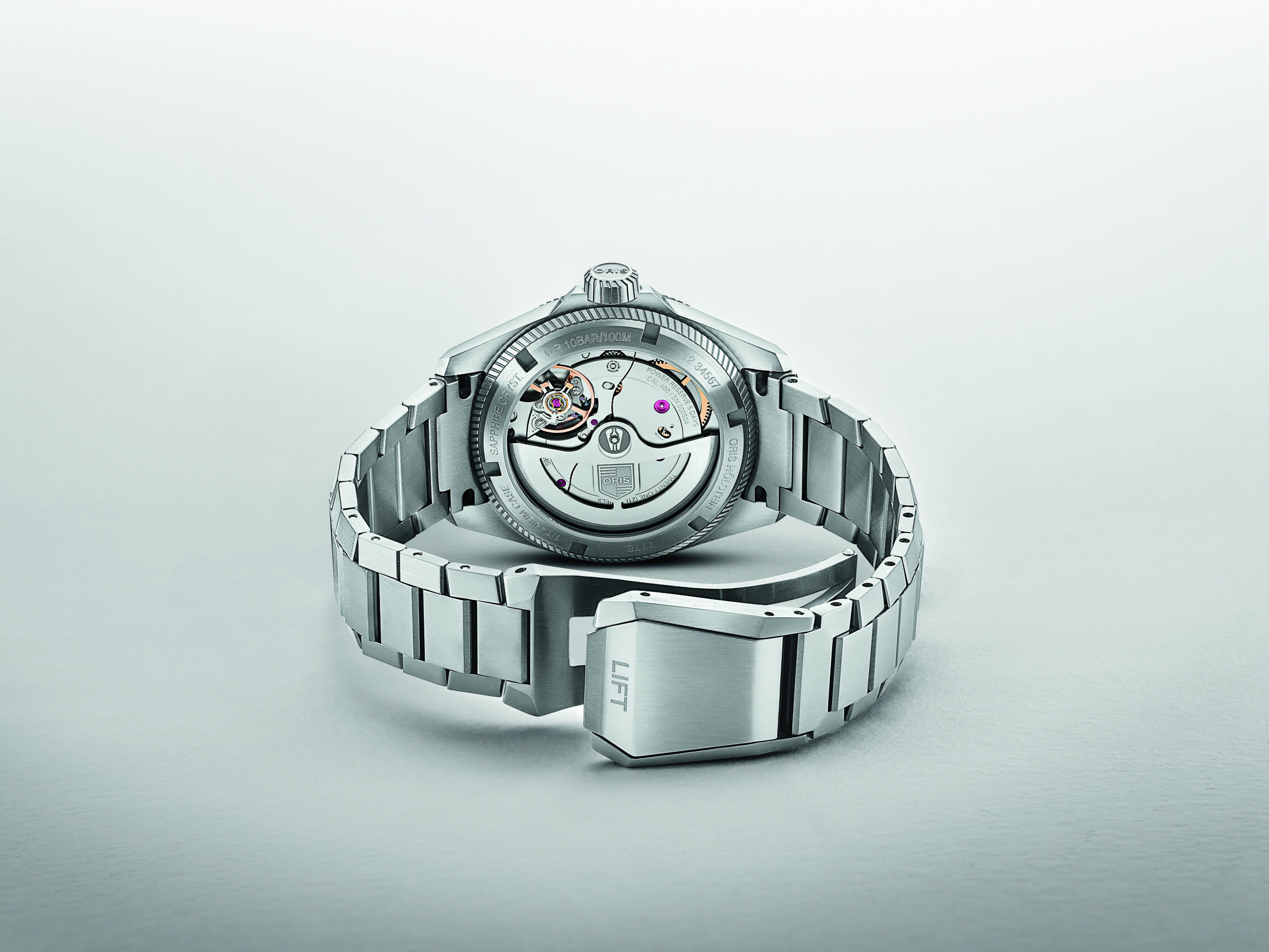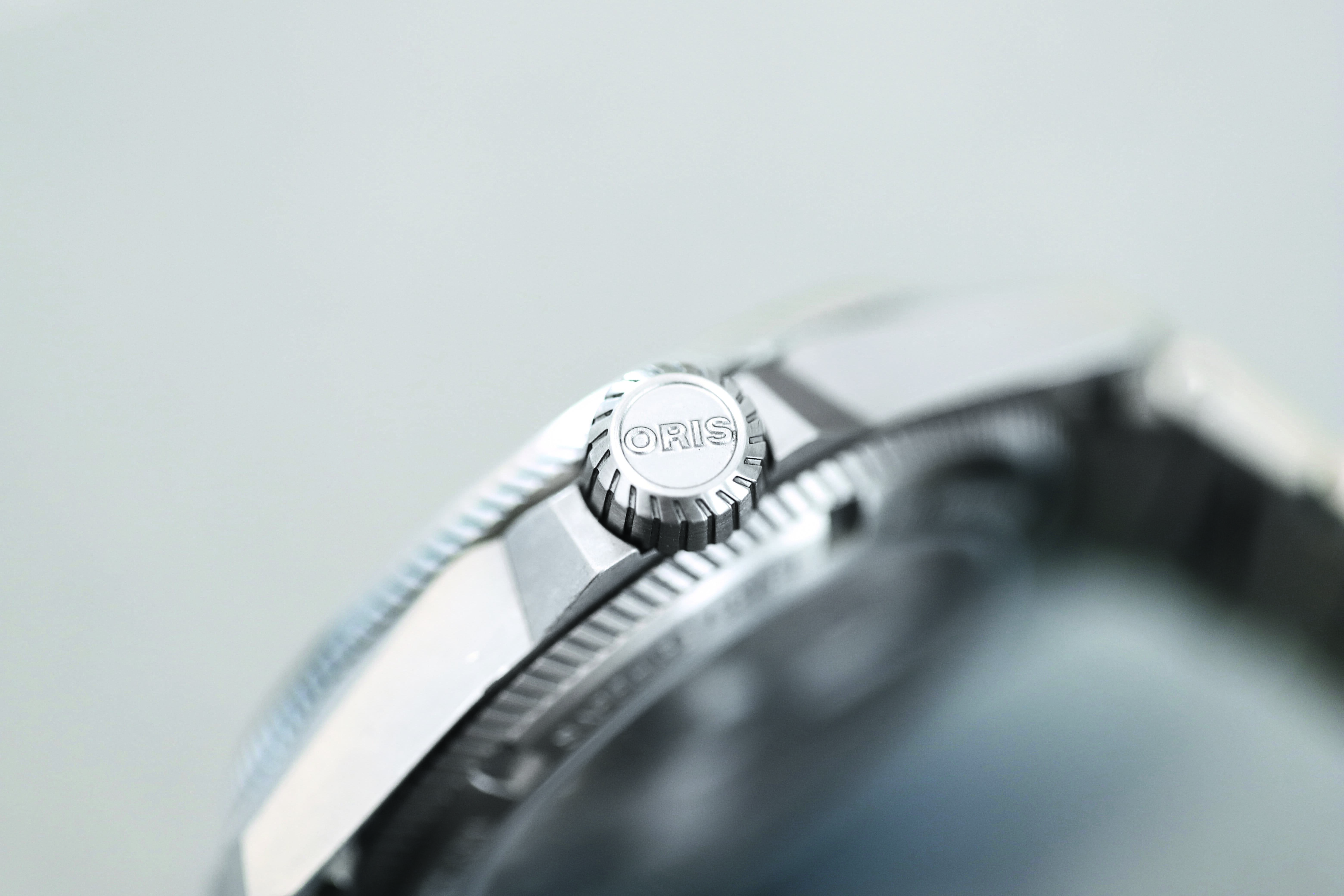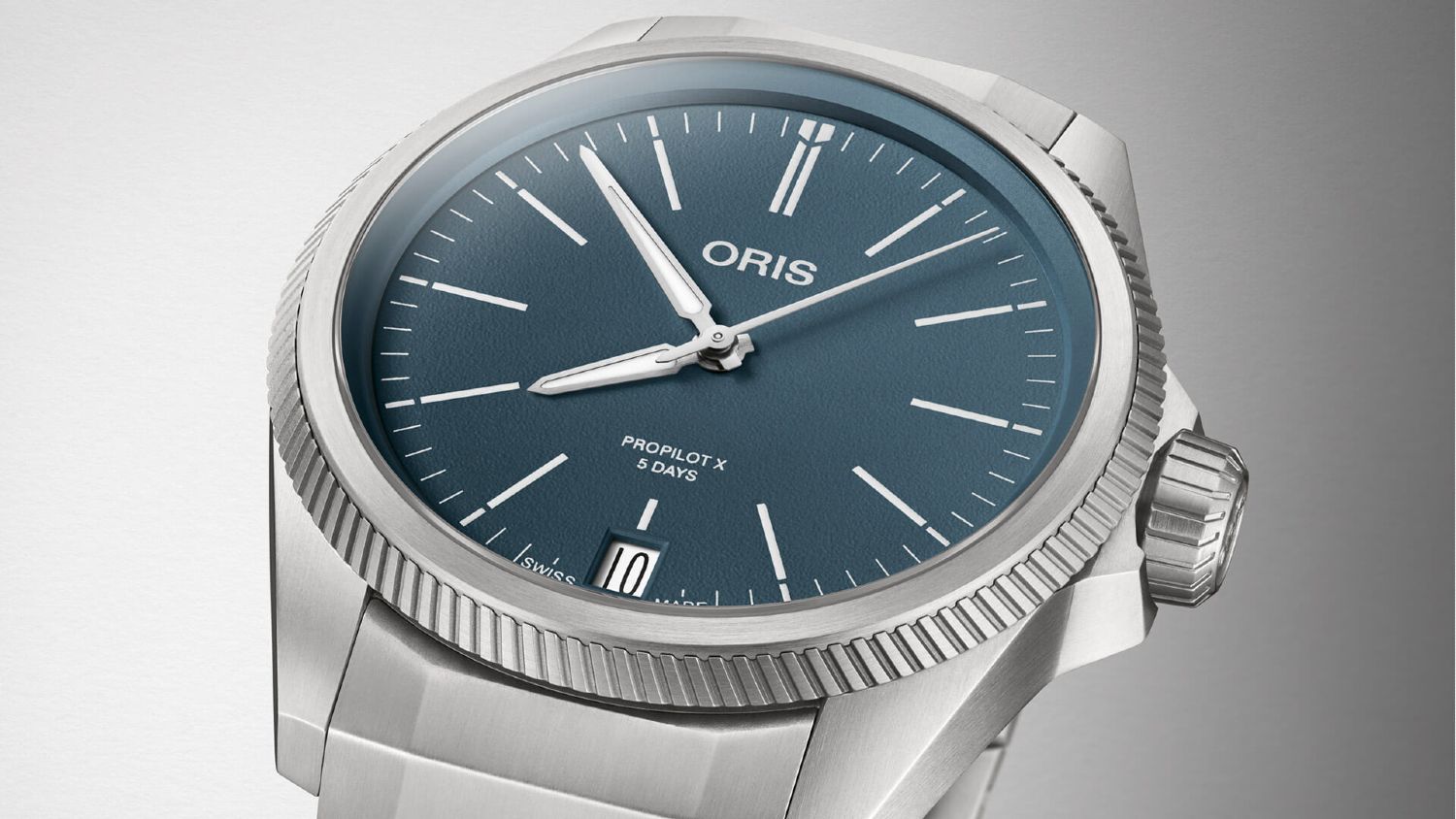When you first look at the Oris ProPilot X Calibre 400, you see a ‘simple’ three-hand watch with a date display. There are no other functions, no features on the case like a rotating bezel or a ceramic insert, and the colour scheme on the dial is only white on blue with no appliqués. Yet something about this watch stirs the watch lover, appealing to his senses and leading him to suspect that a second look could well be worthwhile.
A second glance at this new ProPilot X Calibre 400, our test watch, reveals a unique design language consisting of individually styled hands that sweep over a grained background, a bezel with slanted ribbing, and an angular bracelet that grows out of the case. The large crown is tapered to pick up the diagonal ribbing of the bezel, while the crown protector is just as angular as the bracelet lugs.
All of these details result from a clear design approach that prioritises individuality and a wealth of detail. This principle is continued in the bracelet: The three-row metal wristband is made up of straight inner links and sloping outer links. It gradually tapers and then widens again as it approaches the uniquely shaped folding clasp. The case and bracelet are made of titanium, which has both technical and design advantages because this metal is significantly lighter in weight than stainless steel and also offers a darker, warmer hue.
New Design Approach
The bracelet and case design may be familiar because a ProPilot X has been part of Oris’s product lineup for several years. But a completely different visual effect unfolds here, because the predecessor is a skeletonised watch with a visible 10-day movement, small seconds and Oris’s patented non-linear power-reserve indicator. The technical character is clearly reduced in the new ProPilot X Calibre 400 because Oris’s designers were not aiming to build a ‘talking piece’ with an open movement and special functions, but rather a reliable watch for everyday use.
Also TRead
Although the dial is closed, the special graining of its surface creates a very distinctive look. And here we find another of this model’s special features: The dial’s rough texture not only looks good, it also prevents glaring reflections of the incident light. In this regard, the ProPilot X Calibre 400 continues in the direction of its ancestors, namely Oris’s highly functional and easy-to-read pilots’ watches, which have a long tradition at the brand. Oris unveiled its first pocketwatch for pilots as early as 1910. In 1917, a pocketwatch that was converted to a wristwatch followed suit. The first ‘Big Crown’ wristwatch was introduced in 1938.
Matte surfaces characterise the entire appearance of the ProPilot. Like the dial, the case and bracelet also avoid shiny surfaces that could reflect incident light. This contributes to excellent legibility during the day, which is further enhanced by the well-chosen lengths of the hands. Luminous material on the large hands glows brightly at night, while the short ends of the hour indexes shine less brightly yet still create a sufficiently clear overall picture.
Flawless Operation
On our test watch, it was easy to set the time and date, as well as to open and close the high-quality clasp. The time and date can be adjusted using the large, easy-to-grip, screw-in crown, and the bracelet is operated with the aid of Oris’s patented ‘lift’ system: Simply pull the outer bracket up, like the buckle of an airplane seatbelt, and the sturdy folding clasp opens conveniently. You don’t even need to use your fingernail, because the edge is slightly curved upward and offers your fingertip enough contact surface to grip. Yet it never opens unintentionally in everyday use.
The bracelet’s links are held together by sturdy screw pins, which you only have to open on one side with a screwdriver to shorten the strap. We feel this high-quality, convenient solution should really be standard in the watch industry and wonder why it hasn’t replaced simple split pins.
The bracelet of the ProPilot X wraps comfortably around your wrist thanks to its flexible link construction. And the case, which measures 39mm in diameter and 11.8mm in height, never feels top heavy. All in all, this model’s dimensions are ideal for people with slim to medium-sized wrists. The use of lightweight titanium also plays an important role in terms of wearing comfort. After shortening the bracelet, we weighed our test watch and found that it was just 93 grams. Furthermore, the dark metallic colour of the titanium goes very well with the blue dial.
High-quality Interior
Automatic manufacture Calibre 400, which was launched in 2020, has strong protection against magnetic fields due to 30 antimagnetic components, a power reserve of five days thanks to two barrels (our test watch stopped running after five days and nine hours), and a long service interval of 10 years. The latter is also reflected in the special warranty, which Oris’s customers can extend from two years to 10 years by registering their watch on the brand’s website under ‘MyOris’. The only bit of servicing necessary during the first decade is to have the water resistance checked by a jeweller after five years.
We have previously written about modern, high-performance Calibre 400, and we had only one complaint: When the crown was pulled out to the hand-setting position, the minute hand jumped forward 2 or 3 minutes on two previously tested watches. This was not a serious problem because the hand reliably held its position when the crown was pushed back in again, but the idiosyncrasy was clearly noticeable. This quirk is no longer present on the ProPilot X because Oris has modified the geometry of the relevant components and also added a third hand-setting wheel.
Oris is also precise when it comes to the rate. On average, an Oris watch has to run between -3 and +5 seconds in the individual positions to be sent to a retailer. Our electronic Witschi timing machine confirmed this accuracy. Our test watch posted satisfactory values, with a daily gain of 5 seconds and a maximum deviation of 8 seconds among the several positions. However, several weeks of testing on the wrist revealed somewhat uneven rate performance. Depending on the wearer’s habits and whether or not the mainspring was tightly wound, the ProPilot’s daily gain was between 3 and 6 seconds on some days, but between 10 and 15 seconds on others.
To reduce the daily gain, we recommend periodically giving the watch a full manual winding rather than allowing the 5-day automatic movement to partially run down. Quiet office work didn’t provide enough kinetic energy for the rotor; but after manually winding the mainspring, the movement ran as well as it did during the timekeeping test, which, according to the rules of our testing regimen, is always administered after the mainspring has been fully wound.
Corners and Edges
Our test watch also had a few peculiarities, like a tendency to gain when the movement is not fully wound. Another quirk was that the first few links of the bracelet are not 100 percent in harmony with the design of the band. Instead, an initial connective element integrated into the case is followed by an intermediate link, and only then does the three-row design begin.
Both criticisms are admittedly small, and otherwise this watch surprises with its abilities. In other words, the ProPilot X Calibre 400 is a new model that watch fans will be delighted to discover.
Images courtesy: Oris
